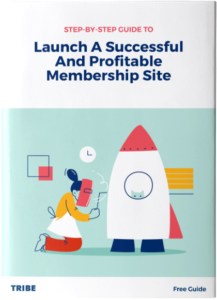Not all membership sites are created equal.
The one you pick will not only make your customer’s life so much better, but it will also make yours better, too!
Don’t just follow the crowd—leverage your unique business strengths to find the perfect fit for you and your audience. This is about turning what you know, love and do into a highly successful membership site.
There are six main types membership site models you can use.
So let’s explore…

1. The Publisher Model
The publisher model is similar to a magazine approach: each month brings a fresh batch of new articles.
The difference is in the content amount. Instead of pages and pages of content, you’ll want to focus on a few pieces of content each month that really help your members make progress.
We know that seems counterintuitive, but in this case, more content actually overwhelms your members and leads to higher drop-off rates.
That’s why we recommend that you limit the membership site to four primary pieces of content, around one focus per week. If you’re using this model, what are your four pieces of content going to be?

2. The UPS Model
Imagine you’re delivering a package each and every month. The items may not be radically different each time, but they bring consistent, reliable content to customers who need it.
For example, TRIBE founder, Stu McLaren and his wife, belong to a membership site that delivers a package of food to their door every month. It’s a regular membership, but the package being delivered contains fresh, organic vegetables and fruit.
What’s a digital version of the UPS model?
One example could be a meal planning membership where each month, members receive a set of meal recipes, instructions, and grocery lists.
The UPS model gives customers the security of knowing exactly what they’re going to receive, making your content part of their routine.

3. The Coaching Model
In this model, your personal involvement is key.
A coaching model can work in terms of group coaching, as well as one-on-one coaching. However, you’ll want to keep scalability in mind.
If you’re offering one-on-one coaching, what would happen if you added 100, 500, or 1,000 members? Would you still be able to provide the experience in the same way? Nope.
But if you’re doing it in a leveraged way where you’re providing coaching to a group of people, or bringing on other coaches, then it absolutely can scale well.

4. The Community-based Membership Model
In this model, people pay month after month to be in a community with other like-minded individuals.
Everyone wants to be with others who share the same passion.
Bringing those people together creates a great, safe community environment. You can continue to serve those people by giving them the place to come together.
A community-based membership model is really powerful once it gets going, because once relationships are developed, your membership site becomes the glue that brings people together, strengthens relationships, and keeps them coming back for more.

5. The Drip Membership Model
What sets the drip membership apart is that at the start, you will have a near-full curriculum of content that gets “dripped” to your members one day, one week, or one month at a time.
No matter when somebody joins the membership, everybody always starts on Day Zero.
Then the next day they get Day One content, Day Two content, etc. Everybody makes the same journey.
Oftentimes with a drip membership, you’ll have people who are on different days of the curriculum. And that’s okay!

6. The Combo Model
As you review the first five models, you may be wondering: do I have to choose just one? Absolutely not! You can mix and match, and create your own combo model.
You may have a little bit of publisher, you may have some coaching in there, you may have a place for community—you don’t have to tie yourself down to one model.
In fact, combining the models actually increases your stick ratio and everyone’s experience as a whole.
So if you can combine a few of these models, it certainly works in your favor.

How to Decide Which Model to Use?
The big question becomes, how do you decide which model to use? It really boils down to two factors: your audience and you.
Your audience. Ask yourself: what will help my audience make progress easier and faster?
What is the best way to serve them to help them get the result that they’re after? Because at the end of the day, when your audience is winning, you’ll be winning.
You. You have to be able to maintain whatever model you choose.
If you don’t like interacting with people, it doesn’t make sense to choose the community-based model. Similarly, if you’re not used to creating ongoing content, the publisher or UPS model will give you more than a little grief. 😉
There will always be ways to create content, coach people, and build a community—even if you don’t like those things, but you need to factor those in right from the start.
So which model is your favorite?
Or, if you can’t choose, how will you mix them up?
Remember, if you understand your unique strengths, you can’t really go wrong!
Check out this video by membership expert, Stu McLaren, explaining the options you have available to you.
Want to learn how to start, grow and scale a successful membership site?
Download this guide, and learn the exact steps to build a successful membership business around what you already know, love and do! Get started TODAY!






